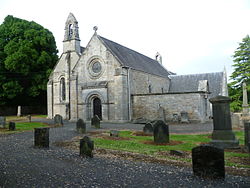Abercorn: Difference between revisions
Created page with '{{Infobox town |name=Abercorn |county=West Lothian |picture=Abercorn Church, West Lothian.JPG |picture caption=Abercorn Church |os grid ref=NT082788 |latitude=55.99334 |longitude…' |
|||
| (One intermediate revision by one other user not shown) | |||
| Line 7: | Line 7: | ||
|latitude=55.99334 | |latitude=55.99334 | ||
|longitude=-3.47326 | |longitude=-3.47326 | ||
|population=490 | |||
|post town=South Queensferry | |||
|postcode=EH30 | |||
|LG district=West Lothian | |LG district=West Lothian | ||
}} | }} | ||
'''Abercorn''' is a village and parish in [[West Lothian]], standing close to the south coast of the [[Firth of Forth]]. The village is around | '''Abercorn''' is a village and parish in [[West Lothian]], standing close to the south coast of the [[Firth of Forth]]. The village is around three miles west of [[South Queensferry]]. | ||
Though a little place today, Abercorn was once the site of a famous monastery. The abbey here is described in Bede's ''Ecclesiastical History of the English People'' by the Old English name ''Æburcurnig'', and it has the coincidental distinction that the earliest appearance of the name "[[England]]" (''Engla land'') is in reference to the location of Abercorn, appearing in the later English translation Bede's book. The name 'Abercorn' appears to be Old Welsh in origin. | Though a little place today, Abercorn was once the site of a famous monastery. The abbey here is described in Bede's ''Ecclesiastical History of the English People'' by the Old English name ''Æburcurnig'', and it has the coincidental distinction that the earliest appearance of the name "[[England]]" (''Engla land'') is in reference to the location of Abercorn, appearing in the later English translation Bede's book. The name 'Abercorn' appears to be Old Welsh in origin. | ||
| Line 23: | Line 26: | ||
==Outside links== | ==Outside links== | ||
{{commons}} | |||
*[http://www.scottish-places.info/towns/townfirst5200.html Gazetteer of Scotland] | *[http://www.scottish-places.info/towns/townfirst5200.html Gazetteer of Scotland] | ||
==References== | ==References== | ||
{{reflist}} | {{reflist}} | ||
Latest revision as of 17:13, 30 April 2018
| Abercorn | |
| West Lothian | |
|---|---|
 Abercorn Church | |
| Location | |
| Grid reference: | NT082788 |
| Location: | 55°59’36"N, 3°28’24"W |
| Data | |
| Population: | 490 |
| Post town: | South Queensferry |
| Postcode: | EH30 |
| Local Government | |
| Council: | West Lothian |
Abercorn is a village and parish in West Lothian, standing close to the south coast of the Firth of Forth. The village is around three miles west of South Queensferry.
Though a little place today, Abercorn was once the site of a famous monastery. The abbey here is described in Bede's Ecclesiastical History of the English People by the Old English name Æburcurnig, and it has the coincidental distinction that the earliest appearance of the name "England" (Engla land) is in reference to the location of Abercorn, appearing in the later English translation Bede's book. The name 'Abercorn' appears to be Old Welsh in origin.
History
The Northumbrian monk and historian Bede mentions Abercorn as the site of a monastery and seat of Bishop Trumwine. The monastery is now known to have existed close to the present day church. The church itself dates partially from the 12th century, although its most interesting features are the private aisles created for the three major families of the area, the Dalyells, the Hamiltons, and later the Hopes, who had their own enclosure behind the altar built by architect William Bruce. The Hope mausoleum, designed by William Burn, is located in the kirkyard. Older burial monuments include Viking "hogback" stones, and fragments of 7th century Northumbrian crosses.[1]
A castle also stood here from Norman times, although it was demolished in 1455 by King James II during a siege against the "Black" earls of Douglas. The House of the Binns, seat of the Dalyell family, is within the parish.[1]
In the 16th century the lands of Abercorn were granted to Claud Hamilton. His son was later created the Earl of Abercorn. In the early 17th century, a branch of the Hamilton dynasty moved to Ulster in Ireland. The family would, henceforth, play a major part in Ulster affairs. Thus, the estate was later sold to the Hope family, who were created Earls of Hopetoun, and built Hopetoun House to the east of the village.[1]
Abercorn's population was recorded as 1,044 at the time of the 1821 census, although it has since declined.[2]
Outside links
| ("Wikimedia Commons" has material about Abercorn) |
